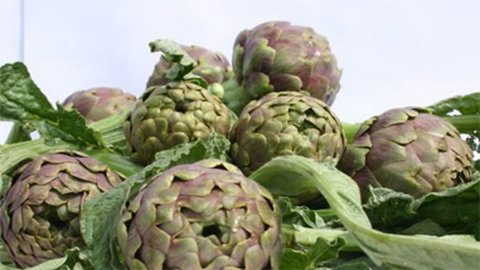Her appeared in the nineteenth century at the time of the Bourbons. Some peasants from Campania brought to the countryside of Capaccio, in the plain dominated by the temples of Paestum, which enjoys an incredible microclimate, protected by the mountains and at the same time benefiting from the temperate effects of the Cilento sea, a typically Mediterranean climate, with mild, rainy winters and hot, dry summers, i first “carducci” of artichoke. Who settled in immediately finding an ideal climate.
But the real diffusion of the artichoke in the Sele valley dates back to around 1930 thanks to the land reclamation and transformation works brought about by the land reform. Bruni spoke extensively about it in 1960, describing the diffusion and importance for the peasant populations of the era of artichoke cultivation, referring to an ecotype derived from the Castellammare artichoke comparable to the Roman artichoke.
What is certain is that the carducci of those Neapolitan farmers today have a respectable name: Artichoke of Paestum IGP also known as Tondo of Paestum, which is characterized by not having thorns, by having a very tender structure, to the point that it can also be eaten raw, and by having a pleasant and delicate flavor which makes it versatile in the kitchen.
Its characteristics are the result of an accurate and laborious cultivation technique that the agricultural operators of the Sele plain have refined over the decades. The tenderness that derives from the cool climate and the abundant rains that fall during the long production period that goes from February to May means that the Artichoke of Paestum PGI is excellent eaten raw seasoned with oil and lemon but also versatile protagonist on the table of various recipes of the local gastronomy: such as the pizza with artichokes, artichoke cream to spread on toasted bread, the artichoke pie, it is also used battered and fried. ,
Being one very early quality its triumph is at Easter: it is a recurring presence in family lunches or outdoor outings when, stuffed with garlic, parsley, salt and pepper, it is placed directly on the embers to cook drizzled with a drizzle of oil and covered with a damp cloth or wet straw paper. The resulting smoke releases extraordinary smoke aromas in the surroundings, not only for those who eat them but also for those who pass through the area. Impossible to resist.
The production area of the Artichoke of Paestum PGI, recognized with community regulation in 2004, is concentrated in the Sele plain in the province of Salerno and more precisely in the municipalities of Agropoli Albanella Altavilla Silentina Battipaglia Bellizzi, Capaccio Cicereale Eboli, Giungano, Montecorvino, Pugliano , Ogliastro, Pontecagnano, Faiano and Serre.
Its characteristics are the result of an accurate and laborious cultivation technique that the agricultural operators of the Sele plain have refined over the decades. First of all, the cool and rainy climate is important, during the long production period that goes from February to May, which characterizes this area and gives the artichoke its typical tenderness and its very delicate flavour.
Beyond its extraordinary flavor, talking about the beneficial properties of the Paestum artichoke or artichoke in general is equivalent to opening a book of medicine.
From the Humanitas Care website we learn that the artichoke The artichoke favors the good bowel function, reduces the risk of colon cancer by supplying a good quantity of fibers which, together with cinerine, an active ingredient which however is reduced by cooking, and lactone sesquiterpenes, also help to reduce blood cholesterol levels. The artichoke is also a source of molecules characterized by antioxidant properties which help defend the body from the action of free radicals and B vitamins, important for the good functioning of the metabolism.
In particular, vitamin B9 (provided by the artichoke in the form of folate) promotes the correct development of the nervous system in the early stages of pregnancy. Vitamin K, on the other hand, is useful for bone and brain health, potassium protects the cardiovascular health, copper and iron are important for production of red blood cells.
And that's not all because the artichoke also contains alpha carotene, lutein and zeaxanthin, silymarin, caffeic acid and ferulic acid. Fans of vitamins and minerals will find you at plenty of vitamin A, manganese, copper, selenium, magnesium, calcium, iron, folate, potassium, sodium phosphorus. How to say a bit of all those substances that we look for expensive pharmaceutical supplements to cultivate our body which, vice versa, in the artichoke we find in the natural state.
In short, the artichoke as well as being a delight for our palate is a real panacea for many problems of our body and is therefore worth consume large quantities especially in this period of the year.





